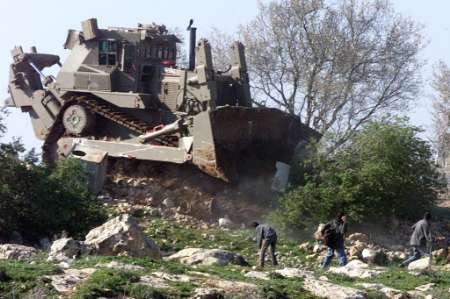
Hana Levi Julian. (IsraelNN.com). 19 Tishrei 5768, October 1, '07. After a chilly night in the hills of Judea and Samaria, dozens of activists awoke to find themselves being evicted from the sites where they hope to build new Jewish communities in the near future.
Hundreds of Jews had spent Sunday night celebrating the holiday of Sukkot on the breezy hilltops, where sparks of light twinkling in the inky darkness were the only signs of other Jewish communities already well-established in the areas.
Although determined to stay, activists at two of the sites were removed by IDF soldiers and police in the early morning light. However, some of the activists fled to nearby vineyards to escape evacuation.
Police swooped down on the dozens of people who camped out in Judea at Ma’alot Halhul in the Judean Hills south of Hevron, evicting them by 8:00 a.m.
One young woman activist said that five black-suited police officers tried to force them off the site Sunday night, but that the activists far outnumbered them. The police later returned with reinforcements and wrecked two sukkot that had been erected, but no serious violence took place. One soldier told IsraelNN.com, "Most of us support you."
Those who stayed overnight at Nofei Hashmonaim, in the Binyamin district, were taken out of the area by police in two groups. One was dropped off at the nearby community of Gamzu and the other was taken to roads leading to Jerusalem.
Activists at three other sites – Harchivi near Elon Moreh, Shvut Ami near Kedumim and Givat HaEitam on the outskirts of Efrat--were joined by supporters from nearby communities as they prayed the morning service. IDF soldiers and police officers were making preparations to carry out evictions there as well.
The ascent to the sites of the five hoped-for communities was carried out Sunday with smiles and song as activists celebrated Sukkot, when holiday booths are built as a reminder of the clouds of glory that protected the Jews in the desert on their way to the Promised Land.
Chief Rabbi Shlomo Riskin led hundreds of Efrat residents to the site of Givat Eitam (Eitam Hill), earmarked to become the city’s newest neighborhood. The site is located within the city limits at the northern edge of Efrat and is intended to connect the eastern and western parts of Gush Etzion.
Another group of activists marched to Shvut Ami (“the return of my people”), to be built in western Samaria, and more hiked their way to to the hilltop of Harhivi (meaning “expand”, based on the passage in Isaiah 54: “Expand the place of thy tent… for thou shalt break forth both right and left”), located in eastern Samaria.
Those who marched to the sites included dozens of children under age 12 and hundreds of teens. “But there were many adults in their 30’s, 40’s and 50’s,” said one activist. “Some were in their 70's.”
Plans are still on for Tuesday’s march to Homesh, one of the four northern Samarian towns destroyed during the Disengagement of 2005.
The organizers have made no secret of their plans to rebuild the town, and have made dozens of ascents to the area over the past several months. MK Aryeh Eldad (National Union) called on the Defense and Public Security Ministers to instruct the police and army to permit and protect the marchers.
Tzvi Ben Gedalyahu and Hillel Fendel contributed to this story
Nessun commento:
Posta un commento